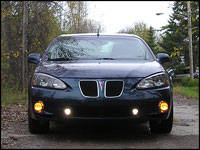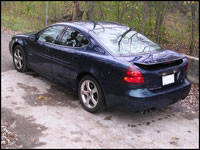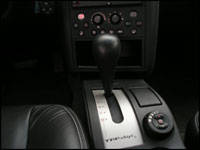* Click HERE to see a video on the Pontiac Grand Prix *
A valianteffort
I can just imagine when GM learned that DaimlerChrysler were planning to launch their rear-wheel drive triplets, the Dodge Magnum, the Chrysler 300 and, recently, the Dodge Charger. Code red! Emergency meeting!
"What do we do now?", says one of the big heads around the table, pulling out the few hairs he has left on his noggin. "Well, we have no rear-wheel drive mid-sizers in the pipeline!", says another, frantically pumping his Player's Light. "Darn merger with the Germans!", shouts another as takes his third shot of scotch from the conference room minibar. Then, a small and hesitant voice is heard; "W-Well, we could sh-shove a small-block V8 in a Grand Prix and see w-w-what happens?", says the young assistant in the corner taking notes, his voice trembling with fear and his knees shaking. The big heads turn to the young guy, look at him with one raised eyebrow each, and all agree that he deserves a promotion and a shot of scotch.
The idea seemed to have convinced the heads at the table. The GXP is GM's reply to the mighty Hemi-powered DCX triplets. But that assistant didn't get his promotion for his idea, though, because he forgot to refill the minibar.
I think the V8 implant in the Grand Prix caused a lot of headaches for GM, though. Looking at the spec sheet, you notice that not only has the front track been increased by almost 2 inches, but the front tires are actually
wider than the rear ones; 255/45R18 versus 225/50R18 in the rear. That's the first time I've seen such a situation. This setup encourages the GXP to oversteer. You see, since the front wheels have to move the car forward and steer it at the same time, while supporting most of the GXP's weight, they would normally have a tendency to resist turning and keep a straight line; that's called understeer. But, by widening the front stance and putting narrower tires in back, the GXP's rear end will let go before the front end in a curve, which will ultimately rotate the car and produce oversteer. Whether this is the right way to tune the handling of a car, or not, is up to you when you try it out.
The real Achille's heel however is obviously torque steer. The 5.3-litre V8 develops 303 horsepower and 323 pound-feet of torque and upsets the front wheels quite a bit during hard acceleration. The front end of the Grand Prix darts left and right, but settles once it is under way. Under normal driving conditions, this problem is minimal, and the traction control is there to make sure things don't get out of control.
The V8 engine is mated to a 4-speed automatic transmission with Pontiac's TapShift manual mode. The transmission's shifts are
silky-smooth, a GM strong point, and the TapShift works as well as any other of these devices in other cars. However, the paddles located on top of the steering wheel spokes are just a little too far from my thumbs; I just left it in 'D', because when you mash the accelerator, the tranny holds its gear up to the engine's redline anyways.
Stepping out of the Grand Prix and into a Dodge Charger, you feel that DaimlerChrysler's steed is a better handler. The difference isn't that noticeable if you're not driving these two sedans back to back, however.
A valianteffort
 |
| 2005 Pontiac Grand Prix GXP (Photo: Michel Deslauriers, Auto123) |
"What do we do now?", says one of the big heads around the table, pulling out the few hairs he has left on his noggin. "Well, we have no rear-wheel drive mid-sizers in the pipeline!", says another, frantically pumping his Player's Light. "Darn merger with the Germans!", shouts another as takes his third shot of scotch from the conference room minibar. Then, a small and hesitant voice is heard; "W-Well, we could sh-shove a small-block V8 in a Grand Prix and see w-w-what happens?", says the young assistant in the corner taking notes, his voice trembling with fear and his knees shaking. The big heads turn to the young guy, look at him with one raised eyebrow each, and all agree that he deserves a promotion and a shot of scotch.
The idea seemed to have convinced the heads at the table. The GXP is GM's reply to the mighty Hemi-powered DCX triplets. But that assistant didn't get his promotion for his idea, though, because he forgot to refill the minibar.
I think the V8 implant in the Grand Prix caused a lot of headaches for GM, though. Looking at the spec sheet, you notice that not only has the front track been increased by almost 2 inches, but the front tires are actually
 |
| 2005 Pontiac Grand Prix GXP (Photo: Michel Deslauriers, Auto123) |
The real Achille's heel however is obviously torque steer. The 5.3-litre V8 develops 303 horsepower and 323 pound-feet of torque and upsets the front wheels quite a bit during hard acceleration. The front end of the Grand Prix darts left and right, but settles once it is under way. Under normal driving conditions, this problem is minimal, and the traction control is there to make sure things don't get out of control.
The V8 engine is mated to a 4-speed automatic transmission with Pontiac's TapShift manual mode. The transmission's shifts are
 |
| 2005 Pontiac Grand Prix GXP (Photo: Michel Deslauriers, Auto123) |
Stepping out of the Grand Prix and into a Dodge Charger, you feel that DaimlerChrysler's steed is a better handler. The difference isn't that noticeable if you're not driving these two sedans back to back, however.


